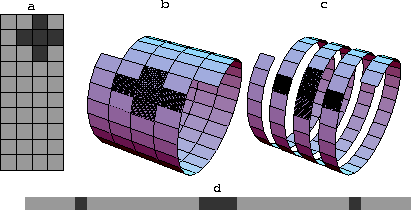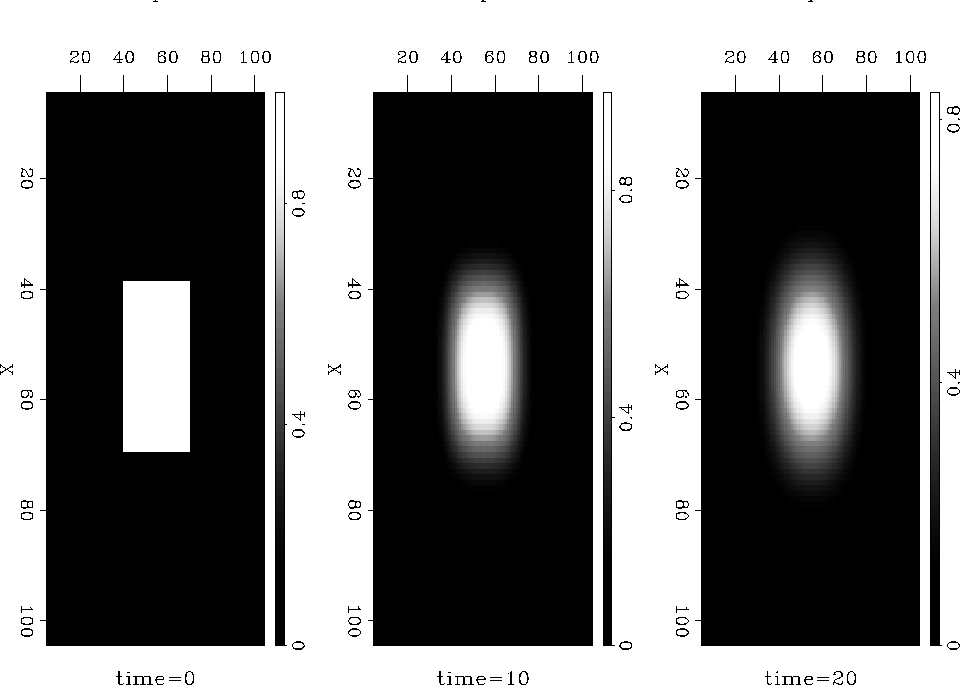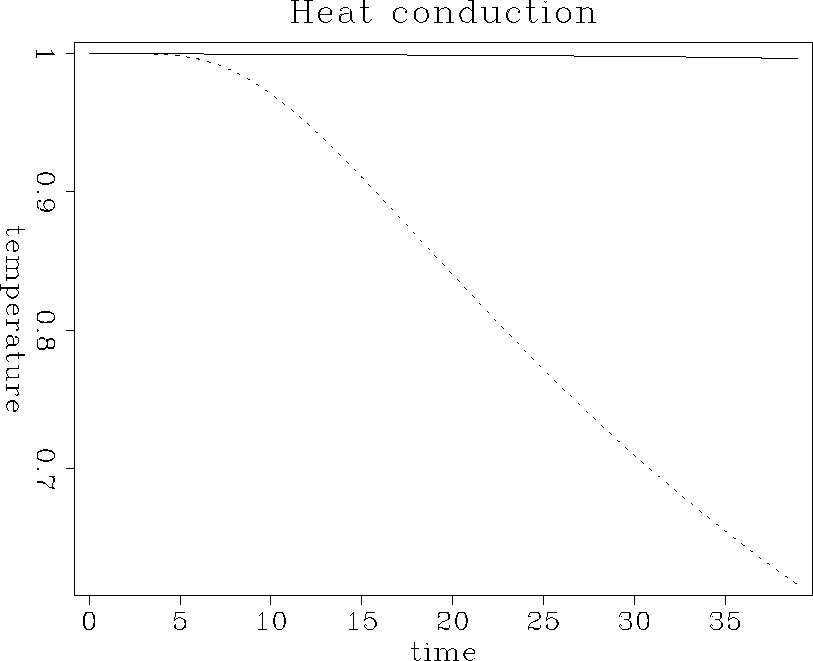![\begin{displaymath}
\tilde{\bold{A}} = \left(\bold{I} -c\,\bold{D}_2\right) =
...
... & & & & -c_{n} \,\bold{I} &
\bold{A}_n
\end{array}\right]\;.\end{displaymath}](img38.gif)
The major obstacle of applying an implicit extrapolation in three dimensions is that the inverted matrix is no longer tridiagonal. If we approximate the second derivative (Laplacian) on the 2-D plane with the commonly used five-point filter Zx-1 + Zy-1 -4 + Zx + Zy, then the matrix on the left side of equation (14), under the usual mapping of vectors from a two-dimensional mesh to one dimension, takes the infamous blocked-tridiagonal form Birkhoff (1971)
![\begin{displaymath}
\tilde{\bold{A}} = \left(\bold{I} -c\,\bold{D}_2\right) =
...
... & & & & -c_{n} \,\bold{I} &
\bold{A}_n
\end{array}\right]\;.\end{displaymath}](img38.gif) |
(17) |
A helix transform , recently proposed by one of the authors
Claerbout (1997a), sheds new light on this old problem.
Let us assume that the extrapolation filter is applied by sliding it
along the x direction in the ![]() plane. The diagonal
discontinuities in matrix
plane. The diagonal
discontinuities in matrix ![]() occur exactly in the
places where the forward leg of the filter slides outside the
computational domain. Let's imagine a situation, where the leg of the
filter that went to the end of the x column, would immediately
appear at the beginning of the next column. This situation defines a
different mapping from two computational dimensions to the one
dimension of linear algebra. The mapping can be understood as the
helix transform, illustrated in Figure 4 and explained
in detail by Claerbout (1997a). According to this
transform, we replace the original two-dimensional filter with a long
one-dimensional filter. The new filter is partially filled with zero
values (corresponding to the back side of the helix), which can be
safely ignored in the convolutional computation.
occur exactly in the
places where the forward leg of the filter slides outside the
computational domain. Let's imagine a situation, where the leg of the
filter that went to the end of the x column, would immediately
appear at the beginning of the next column. This situation defines a
different mapping from two computational dimensions to the one
dimension of linear algebra. The mapping can be understood as the
helix transform, illustrated in Figure 4 and explained
in detail by Claerbout (1997a). According to this
transform, we replace the original two-dimensional filter with a long
one-dimensional filter. The new filter is partially filled with zero
values (corresponding to the back side of the helix), which can be
safely ignored in the convolutional computation.
 |
This is exactly the helix transform that is required to make all the
diagonals of matrix ![]() continuous. In the case of
laterally invariant coefficients, the matrix becomes strictly Toeplitz
(having constant values along the diagonals) and represents a
one-dimensional convolution on the helix surface. Moreover, this
simplified matrix structure applies equally well to larger
second-derivative filters ( such as those described in Appendix B),
with the obvious increase of the number of Toeplitz diagonals.
Inverting matrix
continuous. In the case of
laterally invariant coefficients, the matrix becomes strictly Toeplitz
(having constant values along the diagonals) and represents a
one-dimensional convolution on the helix surface. Moreover, this
simplified matrix structure applies equally well to larger
second-derivative filters ( such as those described in Appendix B),
with the obvious increase of the number of Toeplitz diagonals.
Inverting matrix ![]() becomes once again a simple
inverse filtering problem. To decompose the 2-D filter into a pair
consisting of a causal minimum-phase filter and its adjoint, we can
apply spectral factorization methods from the 1-D filtering theory
Claerbout (1976, 1992), for example,
Kolmogorov's highly efficient method Kolmogorov (1939). Thus, in the case
of a laterally invariant implicit extrapolation, matrix inversion
reduces to a simple and efficient recursive filtering, which we need
to run twice: first in the forward mode, and second in the adjoint
mode.
becomes once again a simple
inverse filtering problem. To decompose the 2-D filter into a pair
consisting of a causal minimum-phase filter and its adjoint, we can
apply spectral factorization methods from the 1-D filtering theory
Claerbout (1976, 1992), for example,
Kolmogorov's highly efficient method Kolmogorov (1939). Thus, in the case
of a laterally invariant implicit extrapolation, matrix inversion
reduces to a simple and efficient recursive filtering, which we need
to run twice: first in the forward mode, and second in the adjoint
mode.
 |
Figure 5 shows the result of applying the helix transform to an implicit heat extrapolation of a two-dimensional temperature distribution. The unconditional stability properties are nicely preserved, which can be verified by examining the plot of changes in the average temperature (Figure 6).
|
heat-mean
Figure 6 Demonstration of the stability of implicit extrapolation. The solid curve shows the normalized mean temperature, which remains nearly constant throughout the extrapolation time. The dashed curve shows the normalized maximum value, which exhibits the expected Gaussian shape. |  |
In principle, we could also treat the case of a laterally invariant coefficient with the help of the Fourier transform. Under what circumstances does the helix approach have an advantage over Fourier methods? One possible situation corresponds to a very large input data size with a relatively small extrapolation filter. In this case, the O(N log N) cost of the fast Fourier transform is comparable with the O(Nf N) cost of the space-domain deconvolution (where N corresponds to the data size, and Nf is the filter size). Another situation is when the boundary conditions of the problem have an essential lateral variation. The latter case may occur in applications of velocity continuation, which we discuss in the next section. Later in this paper, we return to the discussion of problems associated with lateral variations.